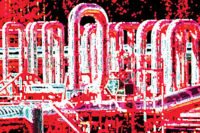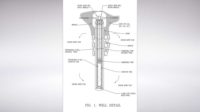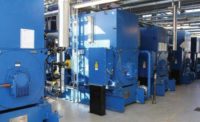As the application of geothermal heat pump technology has evolved, the design engineer has an entirely new set of opportunities to “time shift” energy on both a daily and seasonal basis. This is a major change in thinking for most engineers, requiring an adjustment in their design process from typically focusing on peak loads during design days and instead considering the benefits of harvesting, storing, and distributing energy between multiple loads, sources, and sinks.
RECYCLING ENERGY
Large buildings with diverse uses often have opportunities to move energy; waste heat from air conditioning can serve as a preheat energy source for domestic hot water, etc. If these buildings are connected via some form of an energy-sharing network or “virtual central energy plant,” the opportunities grow enormously and the overall net cost of the needed infrastructure begins to drop. At a recent ASHRAE Conference, an engineer1 presented a case study of a college campus with a common geothermal heat-pump loop interconnecting buildings that totaled nearly 1,500 tons of peak cooling load, yet due to the energy sharing and diversity of the campus, the energy loads were being handled by a geothermal earth heat exchanger that was sized for only 300 tons.
Real-world examples such as this compel the building design team to consider the larger picture beyond their standalone project. This is a challenge in today’s marketplace where we parse large, complex projects into manageable smaller “bits,” often losing the opportunities for energy sharing and cost reduction available when we think in macro terms. We typically separate our mechanical systems by function such as chilled water generation, hot water generation, domestic hot water generation, etc., and design them independently instead of looking for synergistic relationships and opportunities between those systems. Some examples of attempting to take a larger view in both corporate and campus settings follow.
SELF-LEARNING GEOTHERMAL HEAT EXCHANGERS – EXAMPLE PROJECT #1
Example project #1 is a 344,000-sq-ft corporate center being constructed in Michigan for a large food service company. In addition to traditional building functions such as office space and data processing areas, this building houses a large commercial kitchen for traditional food preparation as well as the development of new products. The project includes a snow-melting system at the major entries to improve employee access and safety. These last two items provide an excellent heat sink for much of the excess thermal energy generated by the earlier-noted operations.
The central energy plant consists of several heat recovery chillers totaling 760 tons, as well as two 250-ton custom rooftop units serving a large underfloor air distribution system. What makes this project unique is the integration of dry-cooler sections in the rooftop units, as well as a predictive thermal-management system to control the heat flux to/from the geothermal earth heat exchanger, the dry coolers (a heat rejection option or “sink”), and the snow-melt system (a “discretionary” heating load).
The advanced control technology allows the geothermal heat exchanger to be an intelligent system component instead of merely “pipe in the ground.” Controls track real-time heat flux and then project the heat exchanger performance well into the future allowing corrective action to be automatically applied weeks or months before an overheated or overcooled geothermal heatexchanger situation arises. This control and pump package (Figure 1) is constructed off site in an ISO-9001 facility and arrives at the site pre-wired, with controls installed and programmed and hydronic components flow tested — all significantly reducing construction time, control commissioning time, and subsequently, project risks.
This application of intelligent, self-adapting predictive controls as well as innovative deep-earth directional boring in lieu of some of the vertical geothermal bores allowed the geothermal heat exchanger to be significantly reduced in size and first cost — in this case from $1,500,000 to $1,150,000 while still affording all of the positive benefits of geothermal heat pump technology. Tracking real-time HVAC loads in/out of the geothermal earth heat exchanger and then comparing these loads to design loads enables the system to become even more intelligent over time as the history of actual performance is documented. Instead of the traditional project where controls function best at their first day of operation and then degrade over time, this system actually becomes “smarter” about managing thermal assets and then leveraging them for beneficial use.
THE ADVANCED HYBRID GEOTHERMAL SYSTEM – EXAMPLE PROJECT #2
Example Project #2 is a 20-year-old, 225,000-sq-ft corporate office building located in North Carolina that is the focus of a current feasibility study. The building has four existing 180-ton air-cooled, direct-expansion (DX) rooftop units serving VAV systems with electric reheat coils. This 760-ton system contributes to the documented building electrical peak demand reaching 1,400 kW in the summer and 1,700 kW in the winter.
The HVAC equipment is at or near the end of its viable service life. It could be replaced with similar units and the owner would experience some energy cost reductions due to efficiency improvements. But what if a different perspective were considered?
The existing rooftop units are sized for the peak load of each of their respective zones — in this case, 180 tons per unit. The building’s block-cooling load reaches approximately 600 tons — if a central chilled water cooling plant were applied, the connected capacity could be reduced from 760 to 600 tons. Cooling could be delivered by replacing the existing DX coils in the rooftop units with chilled water coils connected to this central plant — these coils could serve as morning warm-up heating coils as well.
On-peak/off-peak electric rate structures, installation cost savings, and a reduction in the size of the geothermal heat exchanger point to consideration of thermal energy storage. For this application the chiller plant could be reduced again, from 600 tons to 350 tons by the addition of ice thermal energy storage tanks. An additional benefit is that chiller operation during on-peak periods could be as low as 250 tons on a design day offering a huge reduction in summer electrical demand on the order of 35% to 40%.
Winter heating is currently provided solely by electric reheat coils at the VAV boxes. A central energy plant using geothermal heat-pump technology could provide hot water to the new chilled-water coil during morning warm-up operation, then heating would shift back to the electric reheat coils after the building reaches occupied mode. This shift from electric resistance heat at a COP of 1 to heat pump technology with a COP of 3 or more allows a very significant reduction in winter peak electrical demand, in this case on the order of 35%.
The final interesting part of this analysis is the review of geothermal heat exchanger options. For this application, if we sized a vertical geothermal heat exchanger to handle the entire cooling-dominated load, we would need approximately 200,000 borefeet in the ground (or 400,000 lineal feet of pipe). Applying thermal energy storage reduces the peak cooling load that the heat exchanger would see from 600 to 350 tons.
Subsequently the size of the heat exchanger could be reduced to 180,000 borefeet — a 10 % reduction. Finally, the project has a 7.5-acre pond on the site that can also be utilized, allowing a further reduction in the vertical HX portion to 9,000 borefeet while adding much less expensive pond loops totaling 72,000 lineal feet. The overall potential reduction in first cost by applying these strategies is approximately $2 million. The key to achieve this level of benefit is the intelligent management of heat flow to/from the multiple heat sources and sinks — in this case, the vertical closed loop heat exchanger and the pond loop. Both heat exchangers have significantly different performance characteristics that dictate their ability to either dissipate or store thermal energy — intelligent control technology allows us to maximize these characteristics for beneficial performance results.
The geothermal option for this client also opens up significant financial opportunities that would not be available if conventional replacement HVAC equipment were to be applied. These can include a Federal commercial tax credit of 10% of the entire geothermal system cost, bonus depreciation for an installation done in 2011 or 2012, and a 5-yr accelerated depreciation for the HVAC equipment in lieu of the traditional 39-yr period. These incentives combined with energy cost savings can return up to 1/3 of the initial investment in the first 5 years and can generate a positive cash flow upwards of $1 million in the first few years of operation.
THE ENERGY NETWORK – EXAMPLE PROJECT #3
Example project #3 is a 1,000,000-sq-ft college campus located in Indiana that was the subject of a recent conceptual review. The campus has a mix of buildings — academic, recreation, dining, residence halls, and offices. This blend of building types allows a mix of diverse HVAC and other thermal energy source and sink load profiles. Waste heat from academic and office buildings can be used as a source of heat for domestic hot water in the residence halls or for the swimming pool, etc. Energy that cannot be used on a real-time basis can be “stored” for use later in the day or year using multiple geothermal earth heat exchangers. Sharing and “time shifting” energy using a virtual central plant in the form of a networked intelligent geothermal heat exchanger system allows significant opportunities for reducing the total cost of converting the entire campus to more efficient energy systems as well as the quantity overall campus emissions and dependence on fossil fuel.
Single-loop geothermal systems have been promoted and applied by others2. In this configuration (Figure 2), a single pipe is routed in a circular fashion with primary circulation pumps that vary flow rates with fluid temperature differentials measured at multiple points — load and performance data are monitored and subsequently controlled via a central control system. Each building is connected to the loop by additional pumps that move fluid to/from the loop as needed to accommodate the actual building loads. Separate dedicated pumps move energy to/from the loop to dedicated geothermal heat exchangers which can take multiple forms such as vertical, horizontal, or slinky closed loops; deep-earth horizontal directional bored loops; and pond/lake loops.
Hybrid cooling towers and boilers can also be mixed into this system configuration. Again, the application of intelligent geothermal earth heat exchanger control allows the different heat exchangers, sources, and sinks to be configured for optimum operation. A vertical closed-loop heat exchanger might be configured with tighter borehole spacing to allow more effective heat storage, whereas other heat exchangers might be designed to more rapidly dissipate heat — the options for both the design engineer and the campus facility-management strategy are nearly endless, and by monitoring and “learning” the performance profiles over time, the networked energy system can become more and more efficient.
When multiple buildings with varying load profiles are mixed together using the concept of a virtual central energy plant, the potential for first-cost reductions can get to be quite large. The challenge is overcoming the initial expense of installing the primary loop; however, several financial options do exist to spread this cost out over an extended period of time in a manner that can provide very good returns on that investment.
Non-taxpaying entities such as this college do not qualify for federal tax-related incentives; however, this type of project can be financed and owned by a separate entity that could qualify for these incentives. The net result can take several forms, including options where the cost of the infrastructure is spread out over time, or if the owner pays for the entire project at the beginning, they may see a net 20% to 25% reduction in total project cost. It pays to look at the various financial tools that are available — the project team might consider the assistance of a financial expert with geothermal and renewable energy system finance experience as an integral part of the project team.
The key concept is that the cost of the final build-out of the entire campus will be much less expensive than handling each building as a standalone geothermal project, due to load diversity reducing the net amount of infrastructure that needs to be designed and constructed.
SUMMARY
The advancements being made in intelligent, predictive control of thermally massive energy systems that employ technology such as geothermal heat pumps open many new opportunities to engineers and owners in the design and operation of energy-efficient facilities.
Improved risk management is an additional benefit to this approach; thermal failures in the performance of geothermal heat exchangers where the fluids get too hot or too cold are relatively rare, but the numbers are increasing as the number of installations rise. Currently, most of these failures catch the owner by surprise down systems begin to fail as the loop temperatures exceed operational limits of the attached equipment. Real-time tracking of geothermal loads and heat exchanger performance combined with predictive algorithms that forecast a future condition allow pre-emptive actions to begin well in advance of potential problems. This level of intelligence then provides the additional benefits of optimizing the loop temperatures over time to allow optimum overall total building energy performance as well as identifying the potential availability of additional capacity in a geothermal earth heat exchanger if the owner is considering future changes that might increase the loads on the thermal energy management system.
To maximize the potential benefits these technologies bring, the design engineer must shift the approach from merely a “design day” mentality to one where data-rich, full-year energy models interact with equally data-rich virtual models of building and system components. Intelligent controls can then take this strategy to an operational level with self-learning algorithms and control optimization. These approaches will allow us to make significant progress towards widely achieving net-zero energy buildings. ES
REFERENCES
1. Mescher, P.E., Kirk T. “Geothermal District Systems – A Sustainable Utility.” ASHRAE 2011 Winter Meeting.
2. Mescher, P.E., Kirk T. “Geothermal District Systems – A Sustainable Utility.” ASHRAE 2011 Winter Meeting.





